NORFOLK BROADS
Sunday, January 9th 2005
Report by Neil Glenn
Photos of Mediterranean Gulls by Lynne Demaine©
Potentially, lots of birds to be seen today so I opt for a fairly early start to maximise daylight hours. By 6.00am, all fourteen participants have been picked up and we are at Cantley, Norfolk, by 9.00am.
The smoke coming from the beet factory chimney is horizontal so I am worried that the Bean Geese will be hunkered down behind the many tall clumps of grass out of the wind. The first bird seen on the marsh is a Peregrine sat in a field. The large flocks of Lapwing and Wigeon seem oblivious to its presence!
The shout soon goes up that the Bean Geese have been located. Everyone obtains good ´scope views, though the small flock of Taigas is some way off. An adult and immature Whooper Swan fly through and a couple of Marsh Harriers are quartering the marsh
Our next stop is Buckenham Station. We park the van, cross the railway and walk along the track to the hide alongside the old mill. There are thousands of Wigeon feeding and whistling just yards from the track, an amazing site. It isn't often one gets so close to these enigmatic birds.
Our group manages to fill the hide but we cannot locate the star bird which, by all accounts, is roosting in the long grass. A Marsh Harrier is being mobbed by the Peregrine in the distance and the huge flocks of Lapwing, Golden Plover, Starling and Wigeon occasionally take flight from the raptors. The Teal remain cool though and the star bird remains hidden.
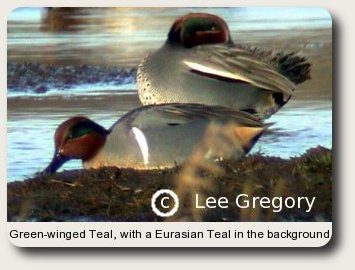
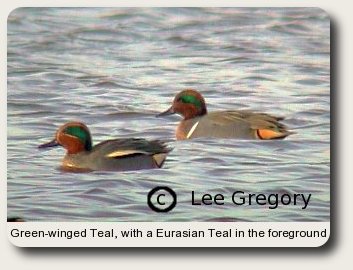
Suddenly, Ian shouts "Green-winged Teal, out here!" from outside the hide. The stampede is greater than for a chocolate bar in the Celebrity Fit Club canteen. Everyone is soon enjoying excellent views of this American rarity, the diagnostic vertical white flank line visible on the sleeping bird.
People drift away but I have one more scan of the marsh for the elusive Water Pipits. No luck but I do find a flock of Barnacle Geese, which brings everyone scampering back. I feel a little guilty when in the back of my mind I seem to think that there is a feral flock in the area. To tick or not to tick?!
The stroll back to the bus reveals more Wigeon, two Ruff and a couple of stunning Stonechats that nearly make a perch out of Ian. Some of us hear a quick burst of song from a Cetti´s Warbler but cannot locate the bird.
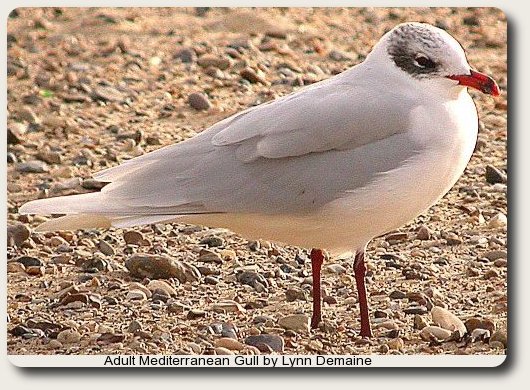
Time is pressing so we head into Great Yarmouth for toilets, sandwiches, Med Gulls – in that order. The beach is devoid of bird life, but a quick walk reveals a lone Mediterranean Gull on the horizon. I throw a couple of pieces of bread in the air and our group are soon surrounded by fourteen Med Gulls of differing ages. They are making their high-pitched call, much different to the lone Black-head´s squawk. When they have had their fill of bread, five stunning adults settle on the beach in front of us while we humans have our lunch.
All very peaceful but we have to move on. We have a choice: try for the Glossy Ibis near Breydon Water, a bird that shows in flight once a week, or drive a little way down the coast for a skulking Dusky Warbler. The former is a very long shot but keeps us nearer our final destination of the day, the latter is a safer bet but we will not get very long on site if it chooses to stay elusive. The decision is made and we head into Suffolk.
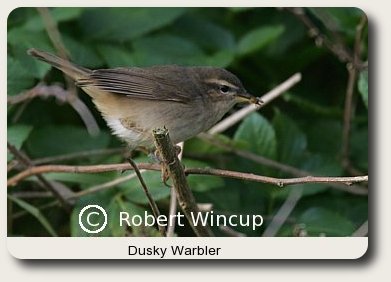
I have never been to Kessingland before, but Derek seems to know it like the back of his hand so we are soon parked up and strolling along the seafront listening for the harsh "chak-chak" of the Dusky. Fortunately, another group of birders soon relocate the bird and we march to where they are standing.
The warbler makes three or four brief appearances, staying low in the vegetation, as Dusky Warblers tend to do. Most get reasonable views but I want to make sure everyone has seen it. The bird duly obliges by popping into the open and proceeds to butcher and eat a bright green caterpillar for all to enjoy. Some even manage to obtain ´scope views before it flies back into deep cover. Superb!
Lynne then finds the local flock of Snow Buntings on the shingle behind us: excellent dessert after the main course. On the way back to the bus, Andrew suddenly shouts "anyone good at caterpillar ID!" He opens his hand to reveal a bright green caterpillar and for one horrible moment I think he has run up the bank and wrestled this poor creature from the Dusky Warbler. Not so: he has found an identical beast.
Our final port of call is the Stubb Mill raptor watchpoint near Hickling. We arrive at 3.00pm to find the viewing bank nearly full to capacity (including three other Notts Birdwatchers) but everyone manages to secure a vantage point. We have already missed two Cranes but there are several Marsh Harriers already on show.
During the next 90 minutes, we are treated to two ring-tailed Hen Harriers, a Barn Owl, a handsome male Kestrel, several skeins of Pink-footed Geese and an incredible twenty-five Marsh Harriers. I don´t think any of the gathered watchers had seen so many Marshies in the air together in Britain before; what an amazing sight. One or two of the group manage to see a Merlin but the Cranes refuse to show. A couple of Chinese Water deer are a mammal tick for most of the group.
It starts to rain and we decide to make a move for the bus. Suddenly, three Cranes appear from over by Horsey Mill in the distance. Unfortunately, they remain in the distance and only give poor ´scope views. I suppose we should be grateful that they showed at all! On the walk back to the bus we are passed by a buggy. Who should be sat in the passenger seat but Ainslie who has somehow blagged a lift back to the car park. How sly is that?!
On the day, seventy four species were seen, with Dusky Warbler a lifer for most people. Some of the group managed four lifers on the trip. Not surprisingly, Bird of the Day was the Dusky Warbler. The vote was taken twice due to some Ukrainian-style vote rigging (without the poison). Mediterranean Gull came second in the vote and Wigeon received a very healthy three votes.
The massed Marsh Harriers, Mediterranean Gulls and Wigeon will long remain in the memory, but surely the rarest sight of the day was the two lycra-clad cyclists pedalling single-file along a country lane
As an Addendum Neil Glenn writes "You may be interested to know that one of the Med Gulls we saw at Yarmouth was ringed in Belgium, was first seen in Britain at Folkstone, came up to Yarmouth, went back to Kent, went back to Belgium, back to Kent and now back to Yarmouth!! Amazing." -- must take the Dover-> Ostend Ferry !!
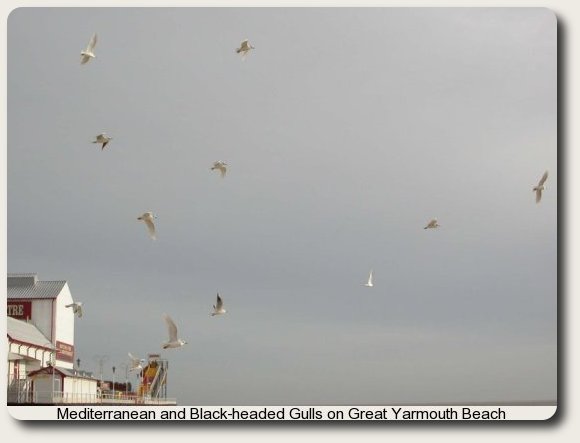
| SPECIES POSITIVELY IDENTIFIED ON THE DAY: | |
|---|---|
| Mute Swan | Lots |
| WHOOPER SWAN | 1 adult, 1 immature Cantley Marsh |
| BEAN GOOSE | approx 10 fabalis, Cantley Marsh |
| PINK-FOOTED GOOSE | Several skeins, Stubb Mill |
| WHITE-FRONTED GOOSE | A few, Buckenham Marsh |
| Greylag Goose | Lots |
| Canada Goose | A few, Cantley Marsh |
| BARNACLE GOOSE | Approx 10, Buckenham Marsh |
| Shelduck | 3, Buckenham Marsh |
| Wigeon | Several thousand, Buckenham & Cantley Marshes |
| Teal | Hundreds, Buckenham & Cantley Marshes |
| GREEN-WINGED TEAL | 1 male, Buckenham Marsh |
| Mallard | Buckenham Marsh |
| Shoveler | Buckenham Marsh |
| Tufted Duck | 1, Buckenham Marsh |
| Common Scoter | 6, Great Yarmouth, heading south |
| Red-legged Partridge | Several, travelling |
| Pheasant | Travelling |
| Cormorant | Everywhere |
| LITTLE EGRET | 1, Breydon Water |
| Grey Heron | 1, Halvergate Marsh |
| MARSH HARRIER | 2, Cantley Marsh; 25, Stubb Mill |
| HEN HARRIER | 2, ring-tailed Stubb Mill |
| Sparrowhawk | Stubb Mill |
| Kestrel | Stubb Mill + good numbers travelling |
| MERLIN | 1 or 2 seen by a few people |
| PEREGRINE | 1, Cantley Marsh |
| Moorhen | 1 or 2, Buckenham Marsh |
| Coot | Lots |
| Common Crane | 3, in flight, Stubb Mill |
| Oystercatcher | 1, Kessingland |
| Golden Plover | Hundreds, Buckenham Marsh |
| Lapwing | Hundreds, everywhere |
| Dunlin | 1, Buckenham Marsh |
| Ruff | 2, Buckenham Marsh |
| Snipe | A few, Buckenham Marsh |
| Curlew | 3, Halvergate Marsh |
| Redshank | 1 or 2, Buckenham Marsh |
| Turnstone | 1 or 2, Kessingland |
| MEDITERRANEAN GULL | 14, Great Yarmouth (at least 5 adults) |
| Black-headed Gull | Lots |
| Common Gull | Several, travelling |
| Greater Black-backed Gull | 1, Stubb Mill |
| Herring Gull | Great Yarmouth |
| Stock Dove | Several, travelling |
| Wood Pigeon | Lots |
| Collared Dove | several |
| BARN OWL | 1 between Grantham & Donington; 1, Stubb Mill |
| Tawny Owl | 4 heard by Steven nr Lowdham while waiting for the bus! |
| Skylark | 1 or 2, Buckenham Marsh |
| Meadow Pipit | 1 heard, Buckenham Marsh |
| Pied Wagtail | Kessingland |
| Wren | Kessingland |
| Dunnock | 1, travelling |
| Robin | Cantley Marsh |
| Stonechat | 1 pair, Buckenham Marsh |
| Blackbird | Travelling |
| Fieldfare | 1 or 2, Cantley Marsh |
| Song Thrush | 1, travelling |
| Mistle Thrush | 2, travelling |
| CETTI'S WARBLER | 1 heard, Buckenham Marsh |
| DUSKY WARBLER | 1, Kessingland |
| Long-tailed Tit | A few, Stubb Mill |
| Blue Tit | Cantley Marsh, etc |
| Great Tit | Near Buckenham Station |
| Magpie | Lots |
| Jackdaw | Lots |
| Rook | Lots |
| Carrion Crow | Lots |
| Starling | Lots |
| House Sparrow | Several, everywhere |
| Chaffinch | Stubb Mill, etc |
| Greenfinch | Travelling |
| Goldfinch | A few, Stubb Mill |
| Linnet | 3, Kessingland |
| SNOW BUNTING | Approx 60, Kessingland |
| Reed Bunting | 1, Buckenham Marsh |
| Mammals | |
|---|---|
| Grey Seal | A few, Great Yarmouth |
| Brown Hare | 2, near Cantley |
| Chinese Water Deer | 2, Stubb Mill |
